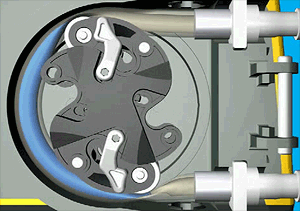Bluelab 120ml/min Peristaltic Pump
Bluelab 120ml/min Peristaltic Pump
Couldn't load pickup availability
A peristaltic pump, known as a roller pump, is a positive displacement pump used for pumping a variety of fluids contained in a flexible tube fitted inside a circular pump casing.
Fluid is moved by the rotary motion of the rotor wipers or rollers attached to the external circumference of the elastomeric tube, compressing the tube as they rotate by.
The fluid is thereby forced to move through the tube as the part of the tube under compression is closed followed by opening to its natural state after the rollers pass by, letting out the fluid at one end while drawing more fluid into the tube at the other end.
Peristaltic pumps may run continuously or they may be indexed through partial revolutions to deliver smaller amounts of fluid.
PharMed® BPT tubing is used to withstand the rigours of the peristaltic pumping action for lengths of time and remains flexible and stable at temperatures between -40°C and 135°C, has low gas permeability and can endure repeated sterilization cycles in an autoclave, made for operations that employ sensitive fluids like hydroponics, agriculture fertigation, biopharmaceutical media mixing, cell culture, harvest and purification.
Product specifications:
- Accurate delivery of nutrients, additives and pH standard solutions to the nutrient solution stock reservoir.
- Automated precise dosing and watering.
- Rated at 120 ml/ min.
- Runs on 24V DC power.
- 0.25″ in/ out peristaltic pump tubing.
- Pressure roller (2H+2R)
- PP made NPT fitting x 2
- ABS enclosure to provide electrical insulation x 1
- DC power wire with 200+1800 mm(L)
- These pumps mount on the wall, above the reservoir.
*As a guide, Bluelab recommends the following maximum concentration for commonly used acids and alkalis and PharMed® BPT peristaltic pump tubing; Nitric Acid <35%, Phosphoric Acid <85%, Sulfuric Acid <30%, Citric Acid <60%, Potassium Hydroxide <60%, Potassium Carbonate Concentrated, Potassium Silicate <60%. The chemical concentrations stated above are a guide. Variations in temperature, pressure, or UV exposure may cause tubing failure which could lead to serious injury if proper safety precautions are not followed. For this reason, it is recommended that the tubing be tested with the desired chemical in the specific application to determine suitability.



